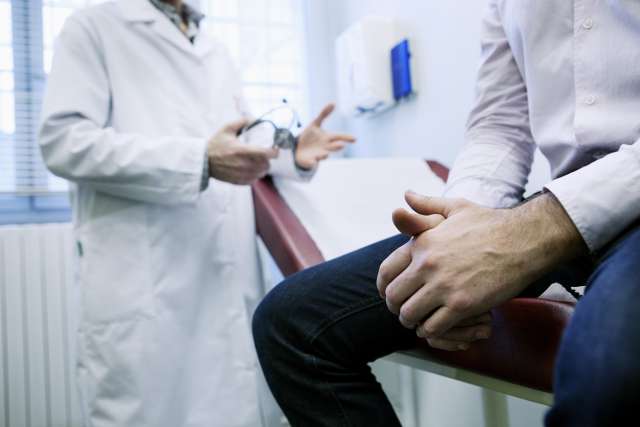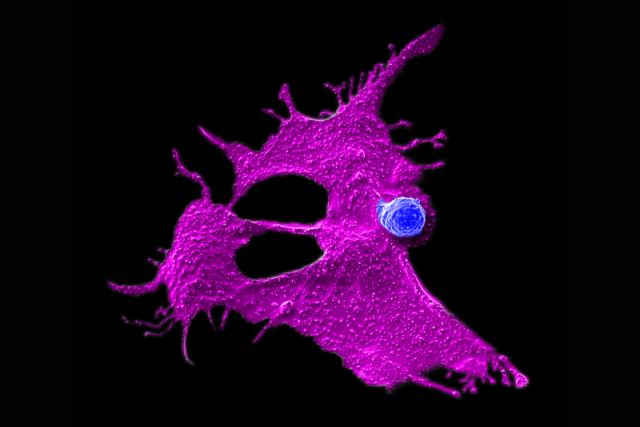Lung cancer is the leading cause of cancer-related deaths nationwide. It develops when abnormal cells in the lungs grow uncontrollably, affecting the lungs’ ability to function properly and often spreading to other parts of the body.
In 2022, the Centers for Disease Control and Prevention (CDC) reported an estimated 220,000 new cases in the United States. In 2023, the CDC reported approximately 132,000 deaths from the disease.
These numbers not only highlight the severity of the disease but also underscore the need for awareness and early detection. According to the American Cancer Society, when the disease is found early, the overall five-year survival rate increases from 27% to 64%.
Current guidelines recommend annual chest CT scans for adults ages 50 to 80 with a significant history of smoking.
“Lung cancer is not just a smoker’s disease; it can affect anyone,” says Bryan Burt, MD, professor and chief of the Division of Thoracic Surgery at UCLA Health and a member of the UCLA Health Jonsson Comprehensive Cancer Center. “The most important message we want to share is that early detection saves lives. We now have effective screening tools, and when lung cancer is found early, patients have many more treatment options and dramatically better outcomes.”
November is Lung Cancer Awareness Month. Here, Sha'Shonda Revels, MD, associate professor in the Division of Thoracic Surgery, addresses commonly asked questions about the disease and offers advice to patients navigating screening, diagnosis and treatment.
Q: How common is lung cancer?
Dr. Revels: Unfortunately, lung cancer is common. It is a huge problem in both the United States and worldwide.
Q: What causes lung cancer?
Dr. Revels: Tobacco use, including smoking, is one of the main culprits. Some people may also have a genetic predisposition to develop different types of cancers, including lung cancer.
In addition, exposure to certain chemicals that people may work with, such as asbestos, or naturally occurring substances in the environment, like radon, can increase the risk. In certain parts of the United States, people are required to have their property tested for radon.
Q: What are signs of lung cancer?
Dr. Revels: Typically, lung cancer does not cause signs or symptoms until it is somewhat advanced. People can develop a cough, shortness of breath, wheezing, chest pain and chest discomfort as the cancer progresses and impacts the lung.
Symptoms outside of respiratory issues such as weight loss, fatigue, bone pain, confusion are signs of an extensive and progressive lung cancer. Unexplained weight loss and severe fatigue should be discussed with a primary physician.
Q: Who should be screened for lung cancer?
Dr. Revels: Based on the information that we know from prior research, we have been able to identify people at the highest risk, and based on our knowledge, that includes people who have used cigarettes and other tobacco products for a significant amount of time.
Those who quit smoking do decrease their susceptibility, but they do have some risk for about anywhere from 15-20 years after they stopped smoking.
Q: Why is screening for lung cancer important?
Dr. Revels: One reason we screen for lung cancer in people identified as high risk is to detect the cancer before patients develop symptoms. Unfortunately, once signs and symptoms develop, the cancer may be too advanced, where it is difficult for us to provide a cure. That’s why screening is so important — it allows us to find cancer very early and intervene as soon as possible.
Q: What tests and scans are used to diagnose lung cancer?
Dr. Revels: When people start to develop signs or symptoms and know they may be at risk, the first step is usually to visit their physician. It is important for their physician to understand their risk factors, including occupational exposures, environmental factors at home, or smoking history.
Then, after a visit to the doctor’s office, evaluation typically begins with a chest X-ray and a CT scan in high-risk individuals to obtain a better picture of the lungs.
Q: What are the types of lung cancer?
Dr. Revels: There are two major types of lung cancer — non-small cell lung cancer and small cell lung cancer. Non-small cell cancer makes up about 85% of lung cancers, and small cell represents the other 15%.
Within non-small cell lung cancer, there are several different types of cancers … but for the most part, we divide lung cancer into small cell and non-small cell cancers, and that determines how we treat it.
Q: What causes lung cancer in nonsmokers?
Dr. Revels: We are unfortunately finding a larger population of people who have developed lung cancer and do not have the stereotypical risk factors, and we are trying to identify how to appropriately include those people in screening. Sometimes it could be related to genetic predispositions or occupational and environmental exposures — and that is something that we're looking into a lot more closely.
For example, there are reports of Asian women who are non-smokers and have developed lung cancer. In some of these cases, specific types of genetic changes are identified in those tumors. And so, we are trying to better identify who those people are and how to screen them because they do not fit our standard description of lung cancer patients.
Q: Is lung cancer treatable?
Dr. Revels: Thankfully, lung cancer is something that is treatable, and there have been a lot of significant changes within the last 10 years. Up until around 2015, we were seeing a plateau in the survival rates for lung cancer. Since then, however, major advances in surgical management, minimally invasive treatments, and medicines have transformed care.
In addition to chemotherapy, we now have immunotherapy that can elicit your own immune system to start fighting the cancer, as well as targeted therapies that allow us to look at the genetics of the tumor and medications designed to target those cancer cells.
Because of those recent changes, people's ability to overcome lung cancer has improved significantly.
Q: How is lung cancer treated?
Dr. Revels: We now have several different ways to treat lung cancer. Treatments include surgery, standard chemotherapy, targeted therapies, immune therapies, ablative procedures, concentrated radiations called SBRT, and sometimes we can freeze the tumors or kill them with heat.
Treatment depends on the stage of the cancer, when it is detected and how well the patient can tolerate different treatments. For example, if a patient cannot undergo surgery or tolerate the removal of a specific area in their lung, then the patient might receive radiation to the tumor site directly or undergo other non-surgical treatments to kill the cancer cells
Q: Is lung cancer curable?
Dr. Revels: Lung cancer is curable. If someone is identified to have lung cancer early enough, we have ability to offer them a cure.
Today, people typically receive several different types of treatment. In some cases, a patient may receive medications first and then undergo surgery. Depending on the results, they might only need close surveillance for several years, or they may require additional treatments. The key is that when lung cancer is identified early, we now have treatments to offer someone a cure — and that is why screening is so important.
Q: How can lung cancer be prevented?
Dr. Revels: The major driver of lung cancer in the United States and worldwide is the use of tobacco. Working to educate people, and in addition to that, providing them with the resources that they need to successfully stop smoking, would make a huge difference in terms of decreasing the incidence of lung cancer.





